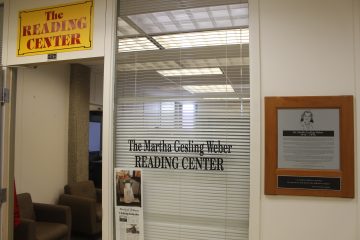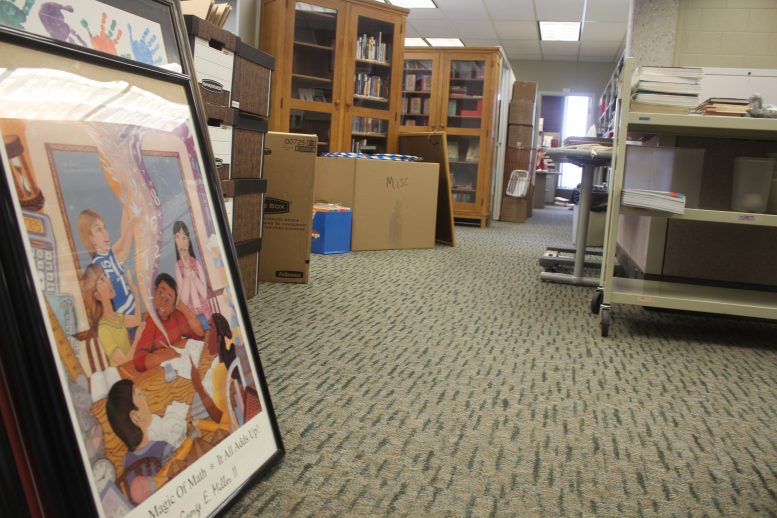By DAVID DUPONT
BG Independent News
The Martha Gesling Weber Reading Center has packed up and is ready to move.
The center closed after 72 years at the end of this semester. A shifting mission and budget deficit is forcing the College of Education and Human Development to reconsider the center’s role.
For now the materials will go to the Curriculum Resource Center on the second floor of Jerome Library while its future is pondered.
 The center has been offering one-on-one reading tutoring for a modest fee for school children. Now it will be up to parents, with some guidance for university personnel, to arrange tutoring with students.
The center has been offering one-on-one reading tutoring for a modest fee for school children. Now it will be up to parents, with some guidance for university personnel, to arrange tutoring with students.
Dean Dawn Shinew, of the College of Education, said that modest fee, attractive to parents, was a large part of the problem. This year the center served about 30 children, she said. Previously it served as many as 60 children. It typically brings in $25,000 in fees. That falls short of the $200,000 it costs to operate the center.
“That’s not a sustainable model,” Shinew said.
One parent called to express concern about the closing and said that a similar service would cost $300 a month at Sylvan, Shinew reaction was: That’s probably what it costs to provide the service.
Founded in 1946, the center is one of the oldest the country. It was named after one of its founders Martha Gesling Weber in 1997.
“It’s a great center and has such a potential for outreach, but it’s tucked the fifth floor of the Education Building, and unless you’re a parent who uses it you wouldn’t know that it’s there,” Shinew said.
The existing parking problems will get worse because of some spaces will be lost as Hanna Hall in expanded and renovated into the new Maurer Family Center, the new home for the College of Business.
“At same time I’m looking at the mission of the reading center because what we were doing was not financially sustainable,” Shinew said.
Originally, she said, the center was more oriented toward research. “It was a place where faculty and graduate students could research the process of learning how to read and try different strategies to see which would be more effective. … Over time it became more of tutoring center.”
That tutoring was appreciated.
Lindsay Moore said her children, a daughter in kindergarten and son in first grade, lacked confidence in their reading. She learned about the center through the Wood County Public Library, and enrolled the children there.
They loved it. Her daughter thought of herself as “going to the university” and proudly wore her lanyard to kindergarten.
“It was amazing,” Moore said. “It was like a transformation. They definitely turned corner in a few weeks. The environment there was so authentic, so pro-child.”
Her children wanted to return they liked it so much. When they learned that the center was closing “it was a bummer,” she said.
Moore said she’d certainly be willing to pay more, but she knows some of the families who used the services could not. Though financially secure now, she remembers when she and her husband were completing their graduate studies and money was very tight.
She said the one-on-one tutoring was a good break from the large classes that the children are in at Kenwood. “That seems large and chaotic, so it’s nice to get them one on one with the teacher in a quiet setting.”
The family moved to Bowling Green in August, and she’s been impressed by the number of offerings for children there are. The reading center was one. “I was overwhelmed by how positive an experience my kids had.”
Given the number of children the center serves, Shinew said, “it’s not a high impact, but it’ significant.”
She worked as a tutor herself. She worked at the center one summer while home from graduate school. “I know the value that it has both for the tutors and the kids they’re working with. But regardless of how good it is, when it’s so heavily subsidized, we can’t continue it.”
Relocating material to Jerome Library will mean “more efficient use of resources, more space, better parking, and greater visibility.”
What takes shape will be the result of conversations both with faculty and staff in the College of Education and with community members.
Shinew said in a year they hope to roll out a new program that’s “better integrated into our undergraduate program.”
One possibility is the revival of the summer reading program which reached hundreds of children, she said. “We batted around some ideas,” she said. “That’s why we put a group together. I’m sure there are possibilities I haven’t even thought of.”
Shinew said: “One of my priorities is we don’t lose the reading center. Whatever it looks like, I think that focus on reading and literacy and supporting learners is critical.”

